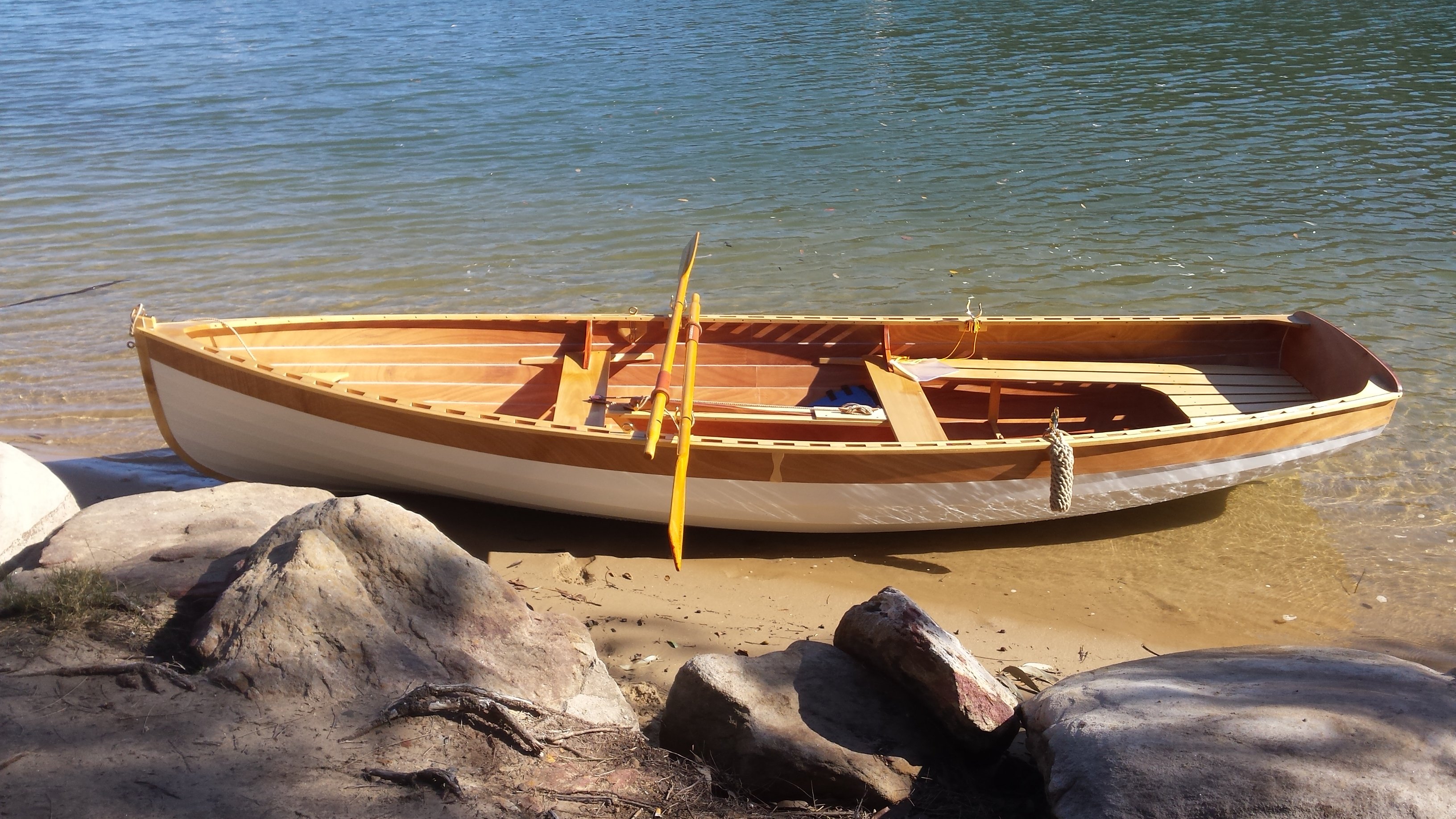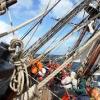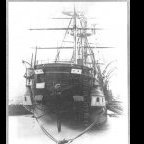MORE HANDBOOKS ARE ON THEIR WAY! We will let you know when they get here.
×
-
Posts
1,281 -
Joined
-
Last visited
Reputation Activity
-
 Bedford reacted to wefalck in Pomeranian Rahschlup 1846 by wefalck – 1/160 scale – single-masted Baltic trading vessel
Bedford reacted to wefalck in Pomeranian Rahschlup 1846 by wefalck – 1/160 scale – single-masted Baltic trading vessel
Thanks to all for your continued encouragement ! Slow progress due to business travel-related absence from the workshop ...
*************
Planking the bulwarks
The planking of the bulwarks follows the same procedure as that for the hull, but had to be handled much more careful, as the inside will be visible and there will by no adjustments possible by sanding or scraping. The main reason for the latter is, that the planks are of scale thickness (0.25 mm) and profiled.
Section through a bulwark drawn by Friis-Pedersen (1980).
As can be seen from the two images above and below, it was not uncommon to give the edges of the planks a decorative profile by using an appropriate profile plane.
Bulwark of a Swedish jagt, photographed in November 2023 in Stockholm
I had been exploring various ideas for creating these profiles on tiny 1 mm x 0.25 mm styrene ‘planks’ uniformly and consistently close to the edges. In the end I decided on a simple and rather makeshift solution: a steel ruler was taped to a small cutting-mat to serve as guide for the very flexible strips. The chosen tool is an old-style ruling pen, of which I have several knocking about in my drawer of draughting utensils. This was set so that it creates a groove close to the opposite edge, when run along the edge of the strip. This works only for strips of uniform width.
It was important to prevent the styrene strips from softening too much during gluing, therefore only tiny drops of liquid styrene cement were applied to each stanchion.
Somehow the alignment of the bulkheads was not as perfect as I was hoping for, resulting in some bulges. I hope I will be able to correct/hide this somehow.
Another problem is that the styrene strips of scale thickness are rather floppy, so that edge-alignment is rather difficult. I hope that I can also sort this out.
Once the planks were on, I installed the hawse-timbers between the stem and the cant-frames in the bow.
Next on will be the rails.
To be continued …
-
 Bedford reacted to Jim Lad in Herzogin Cecilie 1902 by Jim Lad - Four Masted Barque
Bedford reacted to Jim Lad in Herzogin Cecilie 1902 by Jim Lad - Four Masted Barque
A big day for the 'Duchess' yesterday. As you can see from the images, she now has all six yards crossed on the foremast. still some rigging to complete on the royal, but at least its there!
The other big news is that our Senior Curator confirmed to me yesterday that the model has now been accepted into the museum's collection in spite of still being far from completion. This is really big news, as normally only completed models are ever accepted.
John
-
 Bedford reacted to Valeriy V in Libertad 1925 by Valeriy V - Scale 1:100 - Spanish Type F Light Cruiser
Bedford reacted to Valeriy V in Libertad 1925 by Valeriy V - Scale 1:100 - Spanish Type F Light Cruiser
General view of the cruisers hull with side keels.
-
 Bedford reacted to Valeriy V in Libertad 1925 by Valeriy V - Scale 1:100 - Spanish Type F Light Cruiser
Bedford reacted to Valeriy V in Libertad 1925 by Valeriy V - Scale 1:100 - Spanish Type F Light Cruiser
Screw steering device, but without screws.
-
 Bedford reacted to Valeriy V in Libertad 1925 by Valeriy V - Scale 1:100 - Spanish Type F Light Cruiser
Bedford reacted to Valeriy V in Libertad 1925 by Valeriy V - Scale 1:100 - Spanish Type F Light Cruiser
Brazing of propeller shaft brackets.
-
 Bedford reacted to Jim Lad in Herzogin Cecilie 1902 by Jim Lad - Four Masted Barque
Bedford reacted to Jim Lad in Herzogin Cecilie 1902 by Jim Lad - Four Masted Barque
Another update at last. After being away for a couple of weeks and a couple of extremely busy visitor days at the museum, I've finally been able to get a little ore done. Now we have five yards crossed on the foremast - one more to go once I rig the upper topgallant. I've included an image looking along the well deck which shows a little of the scramble of unsecured rigging at this stage.
John
-
 Bedford got a reaction from Javelin in Cangarda 1901 by KeithAug - Scale 1:24 - Steam Yacht
Bedford got a reaction from Javelin in Cangarda 1901 by KeithAug - Scale 1:24 - Steam Yacht
I think a lot of us have been brought undone by the water content of PVA, I know I have, had to pull the bottom off my mahogany runabout model and redo from scratch!
These things keep our minds active, figuring out solutions is an important skill.
-
 Bedford got a reaction from KeithAug in Cangarda 1901 by KeithAug - Scale 1:24 - Steam Yacht
Bedford got a reaction from KeithAug in Cangarda 1901 by KeithAug - Scale 1:24 - Steam Yacht
I think a lot of us have been brought undone by the water content of PVA, I know I have, had to pull the bottom off my mahogany runabout model and redo from scratch!
These things keep our minds active, figuring out solutions is an important skill.
-
 Bedford got a reaction from mtaylor in Cangarda 1901 by KeithAug - Scale 1:24 - Steam Yacht
Bedford got a reaction from mtaylor in Cangarda 1901 by KeithAug - Scale 1:24 - Steam Yacht
I think a lot of us have been brought undone by the water content of PVA, I know I have, had to pull the bottom off my mahogany runabout model and redo from scratch!
These things keep our minds active, figuring out solutions is an important skill.
-
 Bedford got a reaction from FriedClams in Cangarda 1901 by KeithAug - Scale 1:24 - Steam Yacht
Bedford got a reaction from FriedClams in Cangarda 1901 by KeithAug - Scale 1:24 - Steam Yacht
I think a lot of us have been brought undone by the water content of PVA, I know I have, had to pull the bottom off my mahogany runabout model and redo from scratch!
These things keep our minds active, figuring out solutions is an important skill.
-
 Bedford got a reaction from Keith Black in Cangarda 1901 by KeithAug - Scale 1:24 - Steam Yacht
Bedford got a reaction from Keith Black in Cangarda 1901 by KeithAug - Scale 1:24 - Steam Yacht
I think a lot of us have been brought undone by the water content of PVA, I know I have, had to pull the bottom off my mahogany runabout model and redo from scratch!
These things keep our minds active, figuring out solutions is an important skill.
-
 Bedford reacted to KeithAug in Cangarda 1901 by KeithAug - Scale 1:24 - Steam Yacht
Bedford reacted to KeithAug in Cangarda 1901 by KeithAug - Scale 1:24 - Steam Yacht
Thank you Pat, Rick & Gary.
Another week has passed but unfortunately not all weeks go to plan - more of that later.
You will recall in my last post the hull came off the mounting board.
The next task was to remove all the up-stands to deck level. Those of you with long memories will recall that when I cut out the frames I scrolled along the deck line leaving only a small un cut attachment section. You can just about see the cut at arrow "A" in the next photo.
Removing the up-stand therefore only involved two vertical saw cuts at "B" and a horizontal saw cut at "C".
I tried doing the horizontal cut by plunging in a small Dremel circular saw. The saw did a lot of snatching so I tried a diamond cutting disc which proved to be a lot more successful.
I left a small section of building board at the bow to anchor the decoration with an elastic band while gluing.
I then went on to finish the wall cladding inside the engine / boiler room. This small section had been inaccessible from the outside while planking. The cladding is necessasary to produce a smooth internal finish as per the original. The cladding was glued in place using PVA wood glue. The cladding was held in place with pieces of up-stand and clamps while drying.
However this turned out to be a stupid plan because the PVA expanded the hull planks and damaged the hull finish. I am very stupid!
Fortunately only light sanding was required to get the hull smooth again.
Now I get some more varnishing practice.
For the cladding on the other side I have a different plan.
The workshop has been a bit warmer of late so I am hoping for 2 coats of varnish per day. Oh what fun!
-
 Bedford got a reaction from mtaylor in Libertad 1925 by Valeriy V - Scale 1:100 - Spanish Type F Light Cruiser
Bedford got a reaction from mtaylor in Libertad 1925 by Valeriy V - Scale 1:100 - Spanish Type F Light Cruiser
Another master class, and she looks like an interesting ship to model
-
 Bedford got a reaction from eatcrow2 in Libertad 1925 by Valeriy V - Scale 1:100 - Spanish Type F Light Cruiser
Bedford got a reaction from eatcrow2 in Libertad 1925 by Valeriy V - Scale 1:100 - Spanish Type F Light Cruiser
Another master class, and she looks like an interesting ship to model
-
 Bedford got a reaction from Keith Black in Libertad 1925 by Valeriy V - Scale 1:100 - Spanish Type F Light Cruiser
Bedford got a reaction from Keith Black in Libertad 1925 by Valeriy V - Scale 1:100 - Spanish Type F Light Cruiser
Another master class, and she looks like an interesting ship to model
-
 Bedford got a reaction from druxey in Libertad 1925 by Valeriy V - Scale 1:100 - Spanish Type F Light Cruiser
Bedford got a reaction from druxey in Libertad 1925 by Valeriy V - Scale 1:100 - Spanish Type F Light Cruiser
Another master class, and she looks like an interesting ship to model
-
 Bedford got a reaction from Valeriy V in Libertad 1925 by Valeriy V - Scale 1:100 - Spanish Type F Light Cruiser
Bedford got a reaction from Valeriy V in Libertad 1925 by Valeriy V - Scale 1:100 - Spanish Type F Light Cruiser
Another master class, and she looks like an interesting ship to model
-
 Bedford reacted to wefalck in Pomeranian Rahschlup 1846 by wefalck – 1/160 scale – single-masted Baltic trading vessel
Bedford reacted to wefalck in Pomeranian Rahschlup 1846 by wefalck – 1/160 scale – single-masted Baltic trading vessel
Thanks for the 'thumbs up' !
*****************************
Installing the wales
It was fortunate that the upper edge of the wale was marked in the original drawings. I had transferred this to the bulkheads and cut appropriate notches. Somehow, however, these notches turned out to be not very useful as I would have to score the whole core of the hull accordingly, which would have been messy. In the end, I ignored them, though used their upper edge as guidance for placing the wales. I have no information on their dimension, but thought that a width of 240 mm = 1.5 mm looked about right on the hull. They would have been probably composed of two thick planks. For the thickness I choose 0.75 mm, as the hull-planking will be 0.5 mm thick. Contemporary pictures and naval construction books show both options, smooth hulls, where the thicker wales are not visible and step-changes in thickness. I think smooth hulls became fashionable around the middle of the 19th century, but in the Baltic they were always lagging a bit behind, so I went for the stepped design.
Perhaps this is a problem of building up the planking around a solid core, but the way how the wales run against the gilling at the stern caused me some head-scratching. The point where the upper edge of the wale touches the gilling is marked in the original drawings, but it is not clear, where the lower edge touches it. While the wales have an easy run all along the ship, at this point some twisting is needed.
I had not done any planking with styrene before. It turned out to be quite simple: unlike wood, it does not have grain of course and strips can be easily bent and twisted even across the long sides. Pulling the strips around a round piece of e.g. steel causes the strips to curl and one can thus achieve a nice pre-bending without the need of much clamping force, when cementing them on.
Nevertheless, the wales were attached with the recently discovered artificial nail cement, that is a mixture of light-curing acrylic cement and cyanoacrylate. It sets fast, but not so fast that no adjustment would be possible. I let it seep under the wales attached to the hull with Sellotape. Hereby I worked from the more complicated stern forward in more or less long sections, depending on the curvature.
Final clean-up will be done, once the rest of the planking has gone onto the full, with the view to blend everything nicely together.
To be continued ...
-
 Bedford reacted to wefalck in Pomeranian Rahschlup 1846 by wefalck – 1/160 scale – single-masted Baltic trading vessel
Bedford reacted to wefalck in Pomeranian Rahschlup 1846 by wefalck – 1/160 scale – single-masted Baltic trading vessel
Thank you very much for the kind comments and the 'likes' !
*************************************************************
Digression 3
As the start of the planking is imminent, I had to think about a way to shape thin, narrow and long strips of styrene. A clamp is needed that can hold strips down to 1 mm width, 0.25 mm thickness and 150 mm length securely. In addition, the strips have to be held in a way that allows to slightly bevel the edges, if needed. The idea was to clamp the material between to flat metal bars of sufficient stiffness.
I happened to have to matching aluminium bars of 20 mm width and 3 mm thickness that once formed part of a jig and could be repurposed.
The two bars were tightly clamped together and milled flat on the top so that they abut with sharp edges. Then, one edge was bevelled to 45° to give clearance for bevelling the styrene (or wood for that matter) strips. Unfortunately, the table travel of my mill is not long enough to do the milling in one set-up and I could not clamp the whole length of the bars in the vice, which resulted in some chatter marks. Not beautiful, but still functional.
The clamping action is exerted by three thumb-screws for which holes were drilled and tapped.
I stuck a strip of Tamiya masking-tape at about 0.5 mm distance from the top edge in order provide a stop for very thin and narrow material.
Now the clamp has to be tested in anger, to see, whether it really proves useful – not all of my home-made tools that felt like a good idea, really turned out to be that practical 🫢
Building log to be resumed soon …
-
 Bedford reacted to KeithAug in Cangarda 1901 by KeithAug - Scale 1:24 - Steam Yacht
Bedford reacted to KeithAug in Cangarda 1901 by KeithAug - Scale 1:24 - Steam Yacht
Glen, Rick, Keith, MCB, Ian, Eberhard, Pat - thank you all for your continuing support and thanks to everyone for all the likes and visits.
Eberhard, I don't get very stressed about paint it's drilling holes in the hull that traumatises me.
I have been making a bit of progress with the ships bow decoration.
I had previously made the oval feature.
I bought some .04" bearings to create the fringe. They were fixed in position with clear varnish.
I then applied 3 coats of gold paint.
I masked the carvings on the bow and painted them gold.
I also did a bit of repair work to the paint. In one position the masking tape had covered the very edge of the reinforcing plate. I applied a further piece of tape and painted the edge by hand with a very fine brush.
Then it was time to cut the hull from its building board. I used my pull saw to cut each frame in turn.
It took a while but eventually the hull was free and in its building cradle.
I now need to cut all the up-stands off.
-
 Bedford reacted to KeithAug in Cangarda 1901 by KeithAug - Scale 1:24 - Steam Yacht
Bedford reacted to KeithAug in Cangarda 1901 by KeithAug - Scale 1:24 - Steam Yacht
I have spent a few days masking and spraying. Fortunately the workshop temperature has climbed to a balmy 49f / 9.5c.
I completed the masking using a combination of Tamiya tape for the edges and blue painters tape for the less sensitive areas.
The larger areas were covered with paper taped at the edges.
I sprayed a white waterline band using Humbrol white enamel paint.
I then masked off the watering band and exposed the 1/32" ply compensation plates.
Having gone to all that trouble with varnishing the hull I have decided to go minimalist on the hull painting. The new plan is to paint the compensating plates green to match the hull colour. I can always paint the rest of the hull above the waterline if I don't like the result.
Getting the right green wasn't easy but by mixing Humbrol Brunswick with Humbrol Black I was able to achieve something that looked near enough. The lighter green (arrow below) is Brunswick and the second arrow is the Brunswick / Black blend.
I mixed plenty so that I didn't run out mid application.
After leaving the paint to dry overnight I peeled off the tape.
I paid a lot of attention to the tape edges before painting and thankfully the only bleed area was at the bow between the junction of the keel and the hull.
I think I will be able to scrape off the bleed with a sharp blade before touching up with a little varnish. I don't think I need to paint the remainder of the hull above the waterline.
-
 Bedford got a reaction from FriedClams in Pomeranian Rahschlup 1846 by wefalck – 1/160 scale – single-masted Baltic trading vessel
Bedford got a reaction from FriedClams in Pomeranian Rahschlup 1846 by wefalck – 1/160 scale – single-masted Baltic trading vessel
Always a joy to see how you bring these tiny masterpieces together and I'm pleased to know I'm not the only one with a black hole around my work table, I've got a tiled floor and small pieces still disappear!
-
 Bedford got a reaction from Ras Ambrioso in Pomeranian Rahschlup 1846 by wefalck – 1/160 scale – single-masted Baltic trading vessel
Bedford got a reaction from Ras Ambrioso in Pomeranian Rahschlup 1846 by wefalck – 1/160 scale – single-masted Baltic trading vessel
Always a joy to see how you bring these tiny masterpieces together and I'm pleased to know I'm not the only one with a black hole around my work table, I've got a tiled floor and small pieces still disappear!
-
 Bedford got a reaction from KeithAug in Herzogin Cecilie 1902 by Jim Lad - Four Masted Barque
Bedford got a reaction from KeithAug in Herzogin Cecilie 1902 by Jim Lad - Four Masted Barque
That's the beauty of being a volunteer John, they can't really push you either way and they sure can't sack you. Do it in your time mate!
-
 Bedford got a reaction from Keith Black in Pomeranian Rahschlup 1846 by wefalck – 1/160 scale – single-masted Baltic trading vessel
Bedford got a reaction from Keith Black in Pomeranian Rahschlup 1846 by wefalck – 1/160 scale – single-masted Baltic trading vessel
Always a joy to see how you bring these tiny masterpieces together and I'm pleased to know I'm not the only one with a black hole around my work table, I've got a tiled floor and small pieces still disappear!









